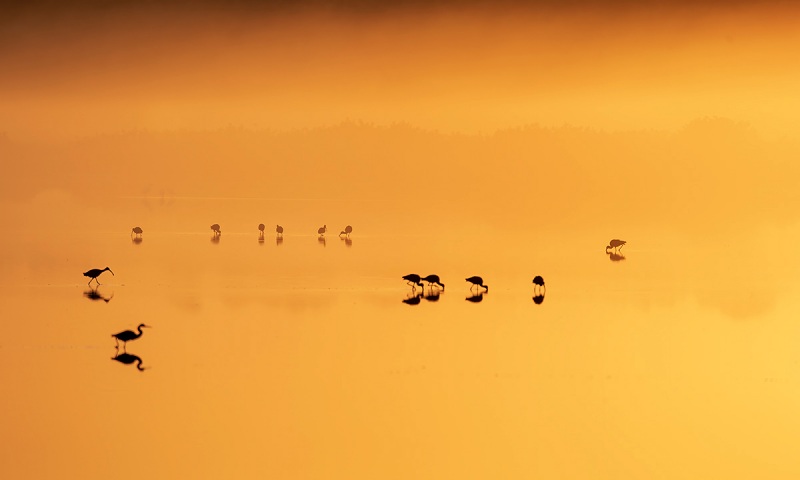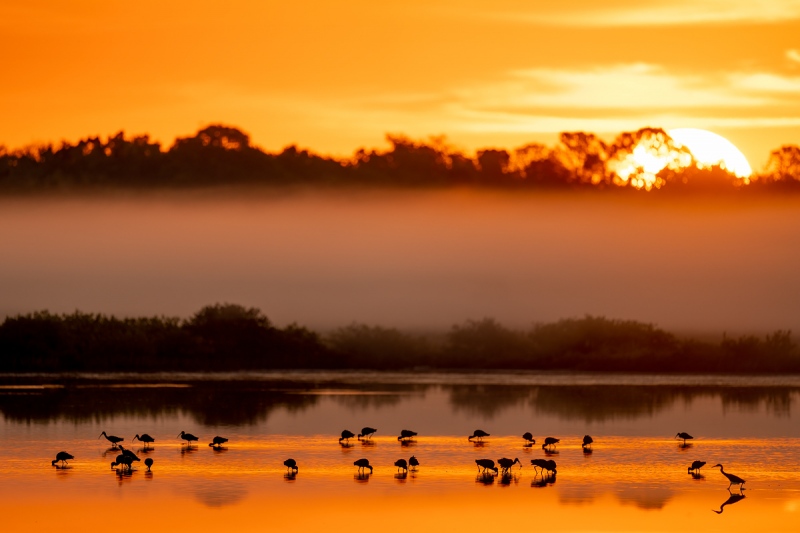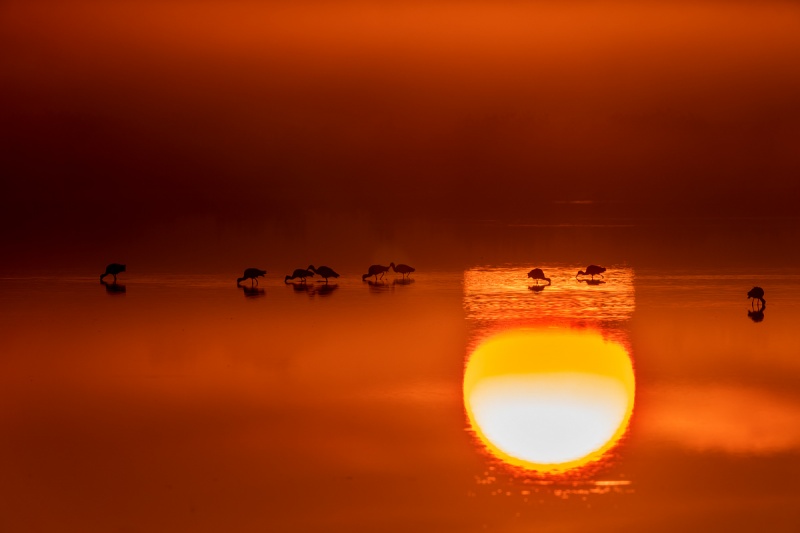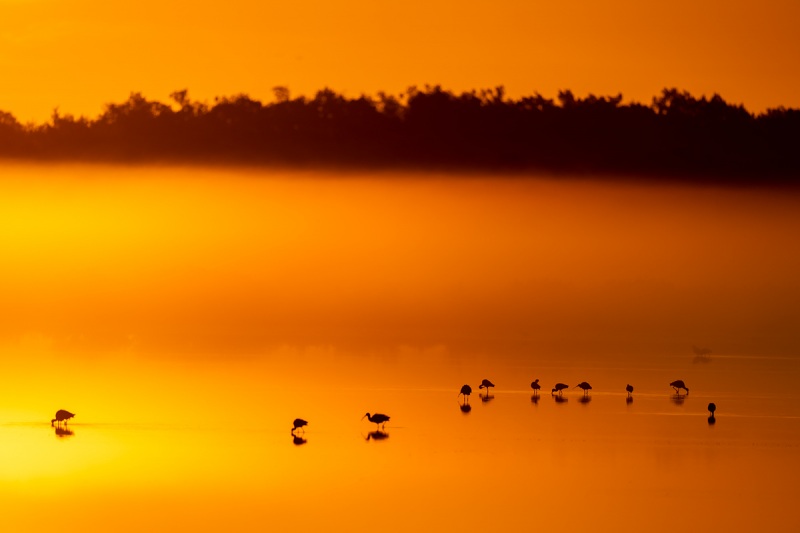What’s Up?
The Merritt Island IPT officially began on the morning of Monday 15 March 2021. (Sunday had been a bonus day for the early arrivers). We had some more ground fog/fire in the mist conditions, and once the sun came up, the fog rose and turned everything to the east various shades of white, silver, and black. It was pretty cool. After that, the sun broke through the fog and we photographed a big raft of American Coots while we worked on both image design and exposure. Next we came across a Willet chowing down relentlessly on a Horseshoe Crab carcass until a drop-dead gorgeous Tricolored Heron in full breeding plumage came by and stole the show. Once the tricolored departed we went back to the Willet that was still pounding away. I tried my first a1 video (at 1200mm) and it came out pretty neat. We were about ready to head home fairly early when we came upon two small pools chock full of Snowy Egrets, White Ibises, and an assortment of other wading birds. The snowies were dip-feeding, but because the pools were small and the birds many, isolating a single bird was tough. But all four of us kept trying until we could barely lift our lenses. We had many good chances with birds in flight and those got even better when a few light clouds came by and softened the light and the shadows. We wound up photographing until 11:15am!
Next up was brunch on the deck of Donna and Bev’s AirBnB; smoked salmon, cream cheese, bagels, bagel chips, and a huge delicious salad prepared by Bev. A Pileated Woodpecker flew right over the deck right at us and right down sun angle. If only …
I created more than 2900 images during our morning shoot and kept 228 after the first edit! The Sony Alpha a1, once again paired with the 200-600 G, performed superbly; the AF system of the Alpha a1 is the best I have ever used.
Our evening session was fair with a nice Reddish Egret and some Blue-winged Teal. I found an excellent new spot for sunset, and the sky was coloring up nicely until the sun disappeared too-early behind a distant fog bank.
I did not have a single moment to devote to the R5 Guide on Monday.
Today is Tuesday 16 March. The morning forecast for Merritt Island is for partly to mostly cloudy skies with a light south wind; not bad for bird photography. We are hoping for some sort of sunrise as the last two have been spectacular. Wherever you are and whatever you are doing, I hope that you have a great day.
This blog post took about 1 1/2 hours to prepare and makes eighty-four days in a row with a new one. Please remember to use my B&H affiliate links or to save money at Bedfords by using the BIRDSASART discount code at checkout.
SONY Alpha a1 Set-up and Info Group
The SONY Alpha a1 Set-up and Info Group is going great guns as folks chime in with thoughtful questions and experience-based advice. Yesterday Goeff Newhouse shared an excellent treatise on SONY Eye-AF systems including the Alpha a1’s new Face/Eye Subject Bird option. You can see some the images he made recently with his Alpha a1 on his flickr page here.
And I woke up this morning to an informative e-mail from Craig Elson that contained some excellent questions. I hit Reply All and am still working on that e-mail. Like the R5, the a1 is an incredibly complex camera body.
All who purchased their Alpha a1 bodies via a BAA affiliate link receive a free subscription to the Sony Alpha a1 Set-Up and Info Updates. This same service may be purchased by anyone with an a1 body via a $150.00 Paypal sent to birdsasart@verizon.net indicating payment for Alpha a1 Info Updates. New members will receive all back issues.
Canon EOS R5 Camera User’s e-Guide
I worked on incorporating Bruce Dudek’s edit of the final draft (as noted above). I should have the final PDF done in a few days but I do not want to rush things. I should be getting the complete guide along with the link for the Educational R5 Image Gallery video out no later than Thursday. I hope.
Two weeks ago, I sent out about a dozen copies of the almost finished Canon EOS R5 Camera User’s e-Guide for review to folks who had previously gotten free copies of the R5/R6 AF e-Guide by using my affiliate links to purchase their Canon mirrorless gear. In the same vein, I contacted everyone who purchased the R5/R6 AF e-Guide last week. More recently, folks who purchased the R5/R6 AF Guide were offered the opportunity to purchase a copy the pre-publication guide for review. Many folks have responded with thoughtful reviews, most recently, IPT veteran Warren Howe. And Bruce Dudek has continued to be a valuable resource.
Because the camera and the Menus are so complex, this guide has required a ton of research, a huge amount of time, and a lot of effort; I am thrilled that it is almost finished. The final update of the R5/R6 AF e-Guide has become part of the complete Camera User’s e-Guide; it has already been revised and expanded.
The complete Camera User’s guide will sell for $75.00. Folks who purchased their Canon gear using my links will receive a $65.00 discount; the guide will cost them a nominal $10.00. Folks who spent more than $7500.00 on Canon mirrorless gear using either of my affiliate links (B&H or Bedfords), will receive the Camera User’s e-Guide for free. Folks who purchased the R5/R6 AF e-Guide will receive a $10.00 discount on the User’s e-Guide. The best news is that the end is in sight.
New and Better Bedfords Discount Policy!
You can now save 3% on all of your Bedfords photo gear purchases by entering the BIRDSASART coupon code at checkout. Your discount will be applied to your pre-tax total. In addition, by using the code you will get 2nd day air shipping via Fed Ex.
Grab a Nikon AF-S Teleconverter TC-14E III and save $14.99. Purchase a Canon EOS R5 and your discount will be $116.97. Purchase a Sony FE 600mm f/4 GM OSS lens and save a remarkable $389.94! Your Bedford’s purchase no longer needs to be greater than $1,000.00 for you to receive a discount. The more you spend, the more you save.
Money Saving Reminder
Many have learned that if you need a hot photo item that is out of stock at B&H and would enjoy free second-day air shipping, your best bet is to click here, place an order with Bedfords, and enter the coupon code BIRDSASART at checkout. If an item is out of stock, contact Steve Elkins via e-mail or on his cell phone at (479) 381-2592 (Central time). Be sure to mention the BIRDSASART coupon code and use it for your online order to save 3% and enjoy free 2nd-day air shipping. Steve has been great at getting folks the hot items that are out of stock at B&H and everywhere else. The wait lists at the big stores can be a year or longer for the hard to get items. Steve will surely get you your gear long before that. For the past year, he has been helping BAA Blog folks get their hands on items like the SONY a9 ii, the SONY 200-600 G OSS lens, the Canon EOS R5, the Canon RF 100-500mm lens, and the Nikon 500mm PF. Steve is personable, helpful, and eager to please.


Gear Questions and Advice
Too many folks attending BAA IPTs (remember those?) and dozens of photographers whom I see in the field and on BPN, are–out of ignorance–using the wrong gear especially when it comes to tripods and more especially, tripod heads… Please know that I am always glad to answer your gear questions via e-mail. Those questions might deal with systems, camera bodies, accessories, and/or lens choices and decisions.
|
|
|
This image was created on Friday 14 March by Donna Bourdon on the Merritt Island IPT. She used the hand held Sony FE 200-600mm f/5.6-6.3 G OSS lens (at 600mm) with the blazingly fast AF King, the Sony Alpha a9 II Mirrorless Digital camera body. ISO 160. Exposure determined via Zebras with ISO on the thumb dial: 1/500 sec. at f/6.3 in Manual mode. AWB at 17:37am during a foggy sunrise. Click on the image to enjoy a larger version. Image #1: White Ibises and one small wading bird in the mist |
Way To Go Donna
Thanks to multiple IPT veteran Donna Bourdon for letting me share this image with y’all. Donna lives in Chattanooga, TN, and has traveled all over the world with me. She is very easy to get along with. She is very active on Facebook and her local camera club. I love this image for its simplicity. We have been working on avoiding merges and creating images with pleasing and well-balanced arrangements of the birds. Donna did just that with this image. And I love the barely visible line of mangroves.
After trying the SONY a9 ii/200-600 G lens for a while (and loving it), Donna recently purchased a Canon R5 as she has a large collection of Canon lenses; she is loving the R5 and will likely go back to Canon 100%.
|
|
|
This image was created on 12 March 2021 by yours truly on the Merritt Island IPT. I used the Induro GIT 404L/Levered-clamp FlexShooter Pro-mounted Sony FE 600mm f/4 GM OSS lens and The One, the Sony Alpha 1 Mirrorless digital camera. Auto ISO set ISO 200. Multi-metering at +.7 stops with exposure compensation on the rear dial: 1/500 sec. at f/4 (wide open) in Shutter Priority (S) mode. AWB at 7:36am on a foggy morning. Tracking Flexible Spot/AF-C was active at the moment of exposure and performed perfectly. Click on the image to see a larger version. Image #2: White Ibises and small wading bird in the mist |
Getting the “Right” Exposure with the Sun in the Frame
If you opt to include a too-bright sun in the frame as I did with Images #2 and #3, the sun will be — by necessity — completely over-exposed.If you expose so that the sun is not over-exposed, the rest of the image will be black and opening it up during the post-processing will result in horrific levels of noise at any ISO. The trick is to somewhat limit the over-exposure of the sun ball while having enough light on the rest of the image to render it pleasingly.
|
|
|
This image was created on 12 March 2021 by yours truly on the Merritt Island IPT. I used the Induro GIT 404L/Levered-clamp FlexShooter Pro-mounted Sony FE 600mm f/4 GM OSS lens with the Sony FE 1.4x Teleconverter and The One, the Sony Alpha 1 Mirrorless digital camera. Auto ISO set 100. Multi-metering at zero with exposure compensation on the rear dial: 1/500 sec. at f/13 in Shutter Priority (S) mode. AWB at 7:40am on a foggy sunrise morning. Tracking Flexible Spot/AF-C was active at the moment of exposure and performed perfectly. Click on the image to see a larger version. Image #3: White Ibises and reflection of rising sun ball |
Photographing the Reflection of the Sun Ball in the Water
The reflection of the sun ball in the water will always be less bright than the sun itself in the sky. But with Image #3, even the reflection of the sun ball was still too-bright to be “properly” exposed. If we are lucky enough to get another good sunrise, I might work at 1200mm and try for the keyhole shot. That is where the sun ball (with some birds in it!) is properly exposed and everything else is allowed to go black …
|
|
|
This image was created on 12 March 2021 by yours truly on the Merritt Island IPT. I used the Induro GIT 404L/Levered-clamp FlexShooter Pro-mounted Sony FE 600mm f/4 GM OSS lens and The One, the Sony Alpha 1 Mirrorless digital camera. Auto ISO set ISO 100. Multi-metering at +1.3 stops with exposure compensation on the rear dial: 1/1000 sec. at f/4 (wide open) in Shutter Priority (S) mode. AWB at 7:42am on a foggy sunrise morning. Tracking Flexible Spot/AF-C was active at the moment of exposure and performed perfectly. Click on the image to see a larger version. Image #4: White Ibises/foggy sunrise |
More Simplicity
This image, without the sun ball, is my favorite from the morning. Like Donna’s image that opening this blog post, the image design is a simple one. The exposure was still tricky as I needed to be sure not to over-expose the bright yellows on the left side of the frame; the reflection of the sun in the water was just out of frame left. You should be looking for balanced spacing of the birds along with pleasing compositional balance. In addition, do your very best to avoid merges where one subject overlaps another.
Note: this low-ISO, mega-exposed to the right image without any dark tones did not require the use of Topaz DeNoise as there was zero visible noise when the image was viewed at 400%. That of course, was not the case with Image #2 as there was noise in the dark tones of the mangroves.
When an if you are lucky enough to experience a fire in the mist situation, you will find that designing pleasing images and getting everything as right as possible, can be daunting. You know that you have something really special right in front of you, but that the spectacular light and the fog will only last a few minutes … My advice? Take a deep breath and do your best.
Those who have read this far and wish to share their thoughts on any or all of the images are welcome to do so by leaving a comment.
Typos
With all blog posts, feel free to e-mail or to leave a comment regarding any typos or errors.



















I was thinking about your keyhole pic from your book and wondering why you hadn’t attempted one and then you answered my thought in the discussion of one of your images. Beautiful shots, hats off to Donna and Mr. Morris. Stay Shudder Happy!
Images 1 & 3 are my favorites of the series. No. 3 is my favorite for the color, simplicity and position of the birds. Both images could be printed and displayed side by side. Image 1 is the traditional classic photo and #3 is where you really worked the scene. Very nice and beautiful. Those conditions don’t happen often.
Such fantastic light ! Well done! Great pictures!
What incredible light – simply stunning!
All are interesting!! Great colors and great birds and great sun spots!!
Beautiful images!
Art: My favorite is the second image with the sun, fog and birds — a really special opportunity.